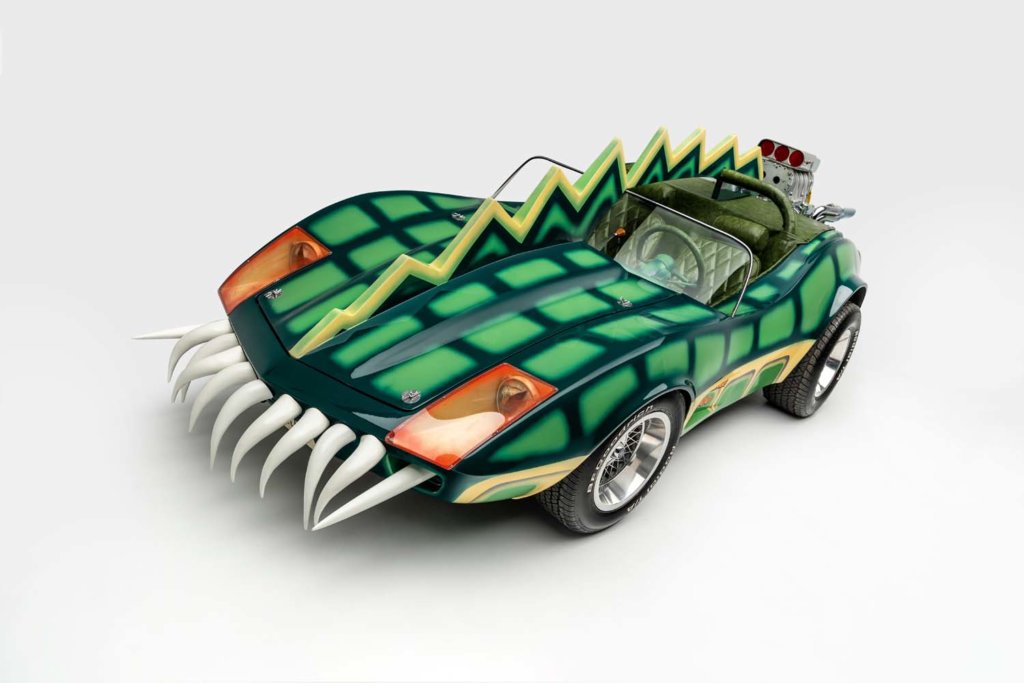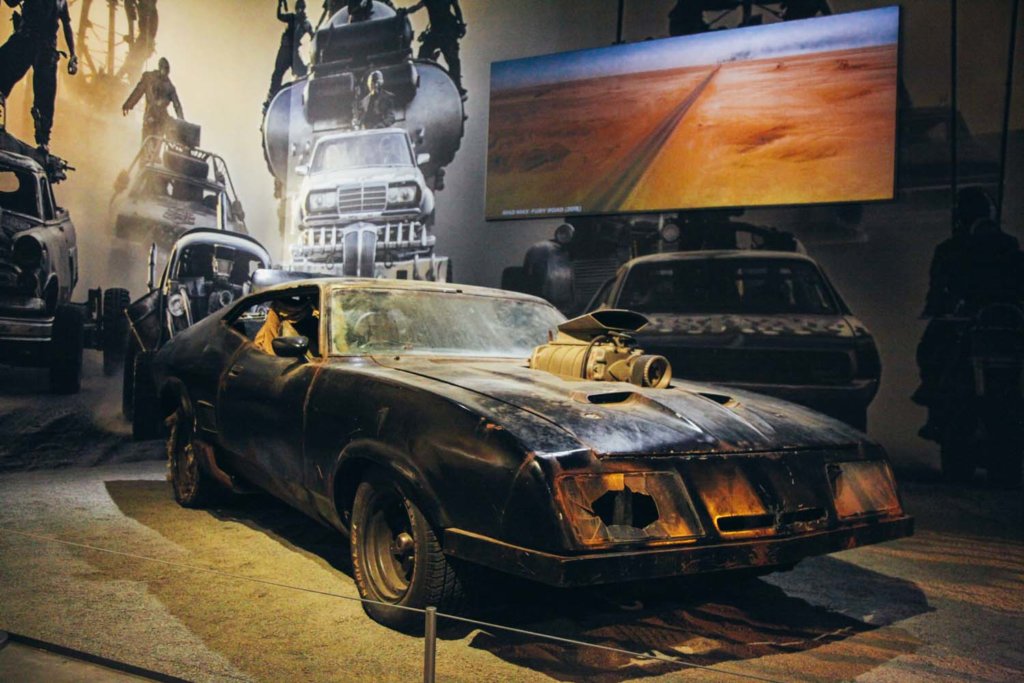For car buffs and movie buffs and movie-car buffs, there are few museum exhibits as cool as the Petersen Automotive Museum’s “Hollywood Dream Machines: Vehicles of Science Fiction and Fantasy.” The exhibit, which opened on May 5, 2019, is the largest museum exhibition of sci-fi vehicles in the world, produced in collaboration with the Comic-Con Museum.
Although originally scheduled to close on March 15, 2020, due to its closure for several months because of the coronavirus pandemic, the Petersen — which reopens to the public on June 19 — has extended the exhibit at least through the end of the year. If you live in the greater Los Angeles area, or have plans to visit soon, don’t miss this one-of-a-kind exhibit.

Some of our favorite vehicles on display in “Hollywood Dream Machines” are not necessarily the coolest vehicles. We’d prefer to drive around in the 1977 Pontiac Firebird Trans Am with the gold “screaming chicken” on the hood from Smokey and the Bandit than the ho-hum-looking 1982 Trans Am that stars as K.I.T.T. in the Knight Rider TV series, but the Bandit’s car doesn’t talk, nor does it have rocket boosters, a flame thrower or an “olfactory sensor,” giving a whole new meaning to the phrase “a car that smells.”
What we love about our top picks from the display are the impact the movies had on us and the leading role these cars, motorcycles or crafts played. This is the world of sci-fi, after all, where imagination often trumps adrenaline. But in some cases, we get plenty of both.
DeLorean Time Machine, Back to the Future I, II, III (1985-1990)

Few sci-fi movie cars are as memorable as the DeLorean that co-starred with Michael J. Fox and Christopher Lloyd in the Back to the Future franchise. The first movie debuted in 1985, just two years after DeLorean Motor Company went bankrupt, and the iconic DeLorean, with its gullwing doors and flat-paneled stainless steel body (Tesla’s Cybertruck, which gets its first public display at the Petersen June 20-27, owes it a debt of gratitude), was built for only two years (1981-82).

“Doc” Brown, inventor of the flux capacitor, chose the DeLorean for his time machine because its stainless-steel body allows for greater “flux dispersal.” The time machine — its license plate said “OUTATIME” — was propelled through time and space, at various times in the movies, by electricity, gasoline, plutonium, wood, coal and even a 19th-century steam locomotive. Three visually distinct DeLoreans were created for the trilogy, but the one on display at the Petersen is the only example to appear in all three films.
Batmobile, Batman (1989) and Batman Returns (1992)

The Petersen exhibit has a replica of the 1960s-era Batmobile, which is cool in a classic Hot Wheels sort of way. But the Batmobile that really knocked our socks off was the long and low (21.7 feet from nose to tail and only 4.3 feet high) machine that appeared in Tim Burton’s Batman (1989) and Batman Returns (1992).

Befitting Burton’s kaleidoscopic imagination, the Batmobile was created from an assemblage of parts, including Rolls-Royce jet engine components to form the hood-mounted intake and turbine blades scavenged from a British Harrier fighter jet. It had tail fins that look like bat wings, machine guns, smoke emitters and a “Batmissile” mode. Its turbine engine made 10,000 horsepower, top speed was 330 mph and maximum jump distance was 7,270 feet. Yes, please.
The Alligator, Death Race 2000 (1975)

Few filmmakers have made as many cult classics as Roger Corman, and one of his more notable gems is the 1975 film Death Race 2000. Produced by Corman and directed by Paul Bartel, it stars a post-Kung Fu David Carradine and a pre-Rocky Sylvester Stallone. The premise of the film is, like most cult classics, a bit of a stretch, but hey, that’s why we love ’em.

After the world collapses in 1979, the tyrannical Mr. President of the United Provinces (formerly the United States) creates the annual Transcontinental Road Race. Unlike the Cannonball Run, this motorsports classic requires five drivers to race across the country while running over pedestrians along the way to score extra points. Leading the race is the mysteriously masked Frankenstein (David Carradine), whose weapon, er, vehicle of choice is the Shala Vette, a custom-built car (Volkswagen chassis, Corvair engine, Corvette body) that resembles an alligator and is equipped with real bull horns for maximum carnage.
Luv’s Spinner, Blade Runner 2049 (2017)

The original 1982 Blade Runner film is one of our all-time favorites, and it featured the dream of every automotive enthusiast: cars that could fly. Unfortunately, the design of the movie’s flying cars — called spinners — was disappointing, even back then. (Back to the Future came out the following year, and its 1981 DeLorean looked more futuristic than any of the cars in Blade Runner.) It took 35 years for the Blade Runner 2049 sequel to come out, and against all odds, it was nearly as good as the original, helped in no small part by the return of Rick Deckard (Harrison Ford).

K, the “blade runner” (a cop who kills replicants, but K happens to be a replicant too) played by Ryan Gosling in Blade Runner 2049, flies around in a thrashed police-issue spinner, but it was light-years ahead of the vehicles used in the first movie. The personal assistant and bodyguard for Niander Wallace (Jared Leto), head of the all-powerful Wallace Corporation, is Luv (Sylvia Hoeks), a creepy, highly polished-and-poised stone-cold killer. Her status and focus on perfection is reflected in her vehicle, which director Denis Villeneuve describes as “the Ferrari of Spinners.”
Main Force Patrol V8 Interceptor, Mad Max: Fury Road (2015)

We saved the best, but certainly not the prettiest, for last. Mad Max: Fury Road is, hands down, one of the best action films ever made. After directing Mad Max (1979), The Road Warrior (1981) and Mad Max: Beyond the Thunderdome (1985), George Mitchell waited 40 years before making his magnum opus, Mad Max: Fury Road. All four movies feature cool, over-the-top cars, trucks and motorcycles, often engaged in fight-to-the-death chase scenes, but Fury Road turned the outrageousness up to 11.

The one car that has been in every movie — even the lead role of “Mad” Max Rockatansky, played by Mel Gibson in the first three films, was replaced by Tom Hardy in Fury Road — is the Main Force Patrol V8 Interceptor, which is based on a 1973 Ford Falcon XB GT Coupe. Thrashed over the course of four films, Mad Max’s Interceptor (“She’s the last of the V8s!”) has a massive blower sticking out of the hood and menacing side pipes jutting out ahead of the rear wheels. Changes to the car over the films include hiding spots for guns and the addition of two massive fuel tanks in the back — to carry the precious “guzzolene” — that are rigged to explode if the car is tampered with.

Also in the exhibit is the Nux Car, a 1934 Chevrolet 5-Window Coupe driven by Nux, one of the War Boys devoted to warlord Immortan Joe in Mad Max: Fury Road. Nux joins the hunt for Imperator Furiosa (Charlize Theron) in his highly modified hot rod, which features a front-mounted crucifix to hold his “blood bag” (Max), who is forced to transfuse with the disease-ridden “half-life” Nux in order to extend his life.
Each vehicle from Fury Road is highly personalized to reflect its driver. The twin-turbocharged, nitrous-infused Chevrolet 5-Window Coupe was chosen to reflect Nux’s wild “revhead” personality. Religious and talismanic objects, along with a rear lancer perch for throwing “thundersticks,” represent Nux’s fanatical devotion to violence and the “Cult of V8” led by Immortan Joe. To earn a place in Valhalla, Nux’s car is rigged to explode in order to ensure his death is anything but mediocre. Makes us want to watch the movie again, for the fifth (sixth?) time….
There are many other cool sci-fi vehicles on display in the “Hollywood Dream Machines” exhibit, such as the Tron Light Cycle (Tron: Legacy [2010]), Durango 95 (A Clockwork Orange [1971]), X-34 Landspeeder (Star Wars Episode IV: A New Hope [1977]), Audi RSQ Sport Coupe Concept (I, Robot [2004]), Skynet Moto-Terminator (Terminator Salvation [2009]), 2054 Lexus Roadster (Minority Report [2002]), Mach 5 Prototype (Speed Racer TV series [1967-1968] and Speed Racer film [2008]), among others, along with concept artwork, props, costumes and memorabilia.
For more information, visit the Petersen Automotive Museum website.
PHOTOS by TED7, courtesy of the Petersen Automotive Museum






